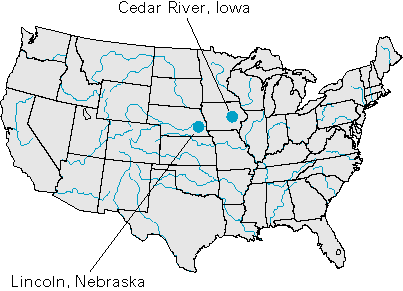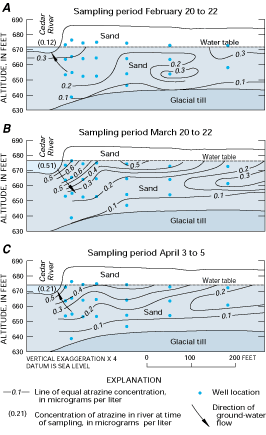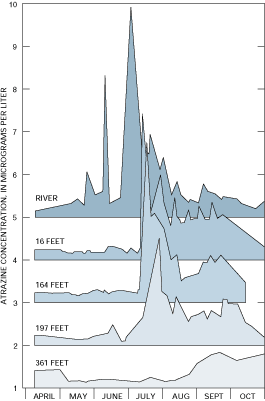P
Effects of Pesticide Application to Agricultural Lands on the Quality of Ground Water and Surface Water
Pesticide contamination of ground water and surface water has become a major environmental issue. Recent studies indicate that pesticides applied to cropland can contaminate the underlying ground water and then move along ground-water flow paths to surface water. In addition, as indicated by the following examples, movement of these pesticides between surface water and ground water can be dynamic in response to factors such as bank storage during periods of high runoff and ground-water withdrawals.
 |
A study of the sources of atrazine, a widely used herbicide detected in the Cedar River and its associated alluvial aquifer in Iowa, indicated that ground water was the major source of atrazine in the river during base-flow conditions. In addition, during periods of high streamflow, surface water containing high concentrations of atrazine moved into the bank sediments and alluvial aquifer, then slowly discharged back to the river as the river level declined. Reversals of flow related to bank storage were documented using data for three sampling periods (Figure P-1). The first sampling (Figure P-1A) was before atrazine was applied to cropland, when concentrations in the river and aquifer were relatively low. The second sampling (Figure P-1B) was after atrazine was applied to cropland upstream. High streamflow at this time caused the river stage to peak almost 6 feet above its base-flow level, which caused the herbicide to move with the river water into the aquifer. By the third sampling date (Figure P-1C), the hydraulic gradient between the river and the alluvial aquifer had reversed again, and atrazine-contaminated water discharged back into the river.
Figure P-1:Concentrations of atrazine increased in the Cedar River in Iowa following applications of the chemical on agricultural areas upstream from a study site. During high streamflow (B), the contaminated river water moved into the alluvial aquifer as bank storage, contaminating ground water. After the river level declined (C), part of the contaminated ground water returned to the river. (Modified from Squillace, P.J., Thurman, E.M., and Furlong, E.T., 1993, Groundwater as a nonpoint source of atrazine and deethylatrazine in a river during base flow conditions: Water Resources Research, v. 29, no. 6, p. 1719-1729.)
In a second study, atrazine was detected in ground water in the alluvial aquifer along the Platte River near Lincoln, Nebraska. Atrazine is not applied in the vicinity of the well field, so it was suspected that ground-water withdrawals at the well field caused contaminated river water to move into the aquifer. To define the source of the atrazine, water samples were collected from monitoring wells located at different distances from the river near the well field. The pattern of concentrations of atrazine in the ground water indicated that peak concentrations of the herbicide showed up sooner in wells close to the river compared to wells farther away (Figure P-2). Peak concentrations of atrazine in ground water were much higher and more distinct during periods of large ground-water withdrawals (July and August) than during periods of much smaller withdrawals (May to early June).
Figure P-2: Pumping of municipal water-supply wells near Lincoln, Nebraska, has induced Platte River water contaminated with atrazine to flow into the aquifer. Distances shown are from river to monitoring well. (Modified from Duncan, D., Pederson, D.T., Shepherd, T.R., and Carr, J.D., 1991, Atrazine used as a tracer of induced recharge: Ground Water Monitoring Review, v. 11, no. 4, p. 144-150.) (Used with permission.)

